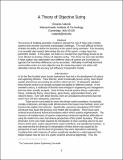A Theory of Objective Sizing
| dc.contributor.author | Valerdi, Ricardo | |
| dc.date.accessioned | 2014-01-23T18:56:29Z | |
| dc.date.available | 2014-01-23T18:56:29Z | |
| dc.date.issued | 2006-05-23 | |
| dc.identifier.uri | http://hdl.handle.net/1721.1/84435 | |
| dc.description.abstract | The process of building parametric models to estimate the cost of large scale complex systems have recently uncovered unanticipated challenges. The most difficult of which includes the ability to define the boundary of the system being estimated. This boundary is an essential step towards determining the size of the system; a major input into parametric models. In this paper, we build on a concept from psychology known as the moon illusion to develop a theory of objective sizing. This theory has two main benefits: it helps explain why stakeholders have different views of systems and it provides an approach for how these differences can be reconciled. Ultimately it will help technical communities arrive at a more objective way for measuring system size which will ultimately improve the accuracy and influence of parametric models. | en_US |
| dc.rights | Attribution-NonCommercial-ShareAlike 3.0 United States | * |
| dc.rights.uri | http://creativecommons.org/licenses/by-nc-sa/3.0/us/ | * |
| dc.subject | parametric models | en_US |
| dc.subject | size | en_US |
| dc.subject | systems | en_US |
| dc.subject | moon illusion | en_US |
| dc.subject | objective sizing | en_US |
| dc.title | A Theory of Objective Sizing | en_US |
| dc.type | Presentation | en_US |
| dc.type | Technical Report | en_US |
